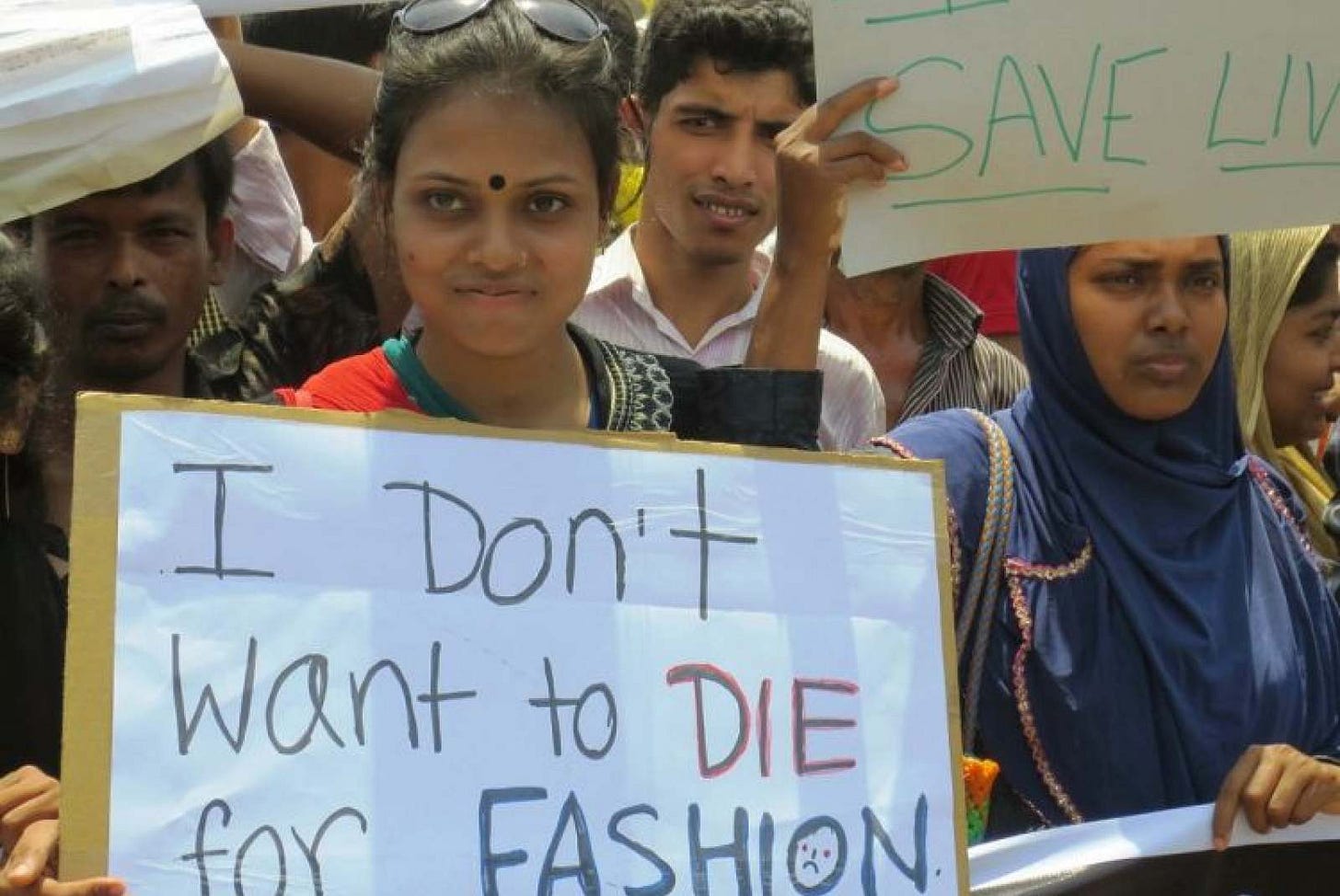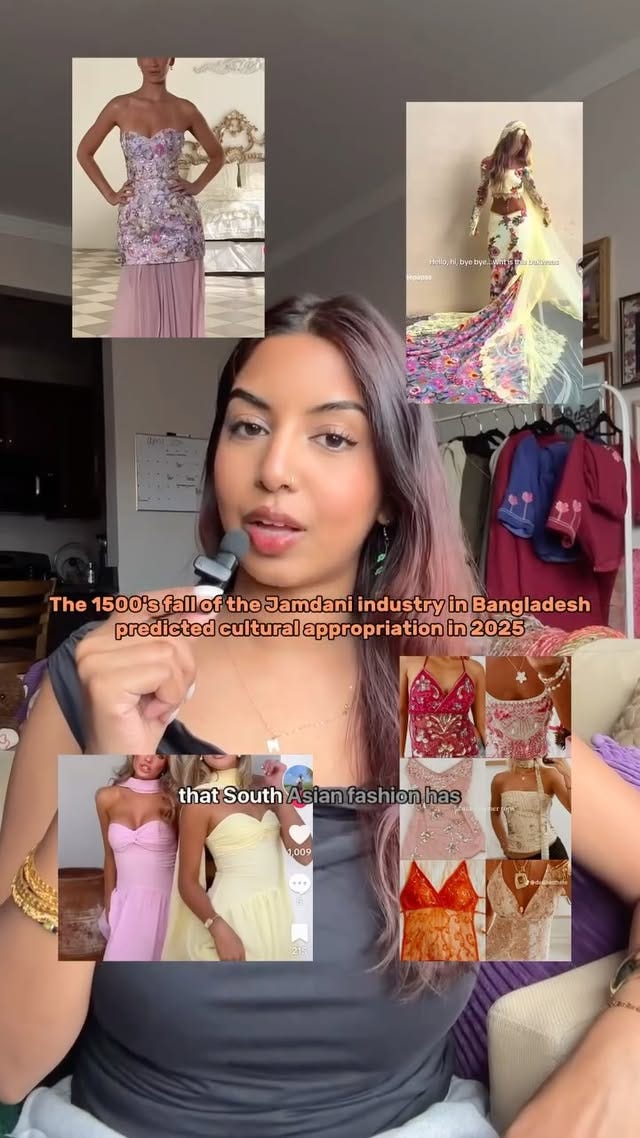While We Argue Over Appropriation, South Asian Workers Are Still Dying
The fashion industry’s colonial legacy is alive and well—in low wages, unsafe factories, and xenophobia.
Twelve years ago this week, the Rana Plaza garment factory collapsed in Dhaka, Bangladesh, killing more than 1,100 workers—most of them young women producing clothing for Western brands like Primark and Walmart. The images of bodies buried under sewing machines and concrete rubble sparked a global reckoning. Consumers swore they’d shop ethically. Brands promised transparency. Labor rights groups rallied for the dignity of the hands that make our clothes.
But fast-forward to now, and it’s hard to find that urgency in the latest trending discourse around South Asian fashion.
Instead, we’re back to the familiar cycle—a white influencer wears a lehenga to Coachella, or a fast fashion brand drops a “new” spring line featuring scarf-draped dresses and ornate embroidery, hailed as “elevated elegance.” South Asian creators call it out. Comment sections spiral. Accusations of appropriation get dismissed as gatekeeping. And someone always asks: Is it really that deep?
Yes. It is exactly that deep.
Because stitched into those garments—whether a $500 “ethnic luxe” dress on Revolve or a viral $12 Zara tunic—is a long history of colonization, economic extraction, human rights violations, and racialized aesthetic erasure.
The global fashion industry’s relationship with South Asia isn’t just visual. It’s violent.
The Fabric of Empire
To understand how we got here, you have to go back—not to TikTok, but to the trade routes of empire.
Long before South Asian styles became music festival staples or red carpet “statements,” they were prized commodities in a global economy. Cotton muslin from Bengal, so fine it was nicknamed “woven air,” dressed Mughal emperors and European aristocrats alike. Chintz and calico from South India fueled an 18th-century fashion craze in France and Britain so intense that lawmakers banned their import—not out of offense, but fear that European industries couldn’t compete.
When the British East India Company arrived, it didn’t just trade. It dismantled. Entire artisan economies were deliberately destroyed to favor British manufacturing. Bengal’s muslin weavers were stripped of their looms and livelihoods; some accounts say their thumbs were severed to prevent them from ever weaving again. Indian textiles were no longer luxury exports—they became colonial plunder.

Even the sari blouse, now seen as “traditional,” is a product of colonial interference. Indian noblewomen were barred from British parties unless they adopted European standards of modesty, leading to the enforced pairing of blouses and petticoats with what had previously been a singular, versatile drape. British influence reshaped not only trade but the very silhouette of South Asian fashion.
Praveen K. Chaudhry, a professor of global fashion management and social sciences at the Fashion Institute of Technology, told The Washington Post that educating consumers about the history and origin of their garments is crucial. For example, many of his students don’t know that the name “cashmere” comes from the Kashmir region.
From Handloom to Sweatshop
Today, the West continues to wear South Asia—only now through the machinery of fast fashion. The region remains the backbone of global garment production, with factories across Bangladesh, India, Pakistan, and Sri Lanka churning out billions of garments each year.
Once handcrafted by skilled artisans, today’s South Asian textiles are often mass-produced under dangerous conditions. Rana Plaza wasn’t an outlier—it was a symptom of an entire system that prioritizes speed and profit over safety and fairness.
In many places, the garment industry is one of the only available sources of income for working-class women, yet it continues to exploit their labor and limit their agency. Many of these workers are descendants of the same families who once hand-dyed silk saris or embroidered zari into wedding shawls—crafts now co-opted as decorative accents on Western “boho” dresses, sold without context or credit.
In Bangladesh, where over 4 million people—most of them women—work in the garment sector, the minimum wage remains around $113 a month. That’s far below a living wage, and workers say it barely covers food, let alone rent or school fees.
Worker-led protests have been met with police crackdowns, tear gas, and mass arrests. In 2019, I reported on garment workers in Dhaka striking for fairer wages. They were beaten with batons, sprayed with water cannons, and some were severely injured. One worker reportedly died. ((Fun fact: the factory owner threatened to sue Elle magazine, where the story originally ran. The piece was pulled—but you can still find it syndicated here.)
Rana Plaza wasn’t a freak accident. It was the visible failure of a system that still exists—and still kills. In 2022, at least two major factory fires in Pakistan and India claimed dozens of lives. In India, unsafe working conditions persist in informal and subcontracted factories, where labor laws are loosely enforced.
Across South Asia, garment workers face long hours, verbal abuse, and wage theft, often with no recourse. During my time reporting on the textiles industry in Bangladesh, I learned that sexual harassment is rampant in factories as the line managers are largely men. Despite advocacy groups sounding the alarm, Western brands turn a blind eye.
Many of these factories supply the same companies that today sell “South Asian-inspired” collections to global consumers with no mention of who made them, how, or at what cost.
Aesthetic Theft in the Age of Visibility
This dissonance becomes especially stark when placed next to the rise in South Asian American cultural visibility. From Kamala Harris to Mindy Kaling, from Sabyasachi on the Met Gala carpet to South Asian influencers racking up millions of views, diaspora culture is hyper-visible—but only when sanitized, profitable, and detached from its politics.
Take the now-viral spring dresses from brands like Reformation and Oh Polly—draped necklines clearly modeled after the South Asian dupatta, but sold as nods to “Old Hollywood glam.” Hollywood, we should remember, has long borrowed its glam from global cultures, especially during colonial and post-colonial eras.
Meanwhile, South Asian influencers point out how dupattas, lehengas, bandhani (tie-dye), and kantha (embroidered quilts) are rebranded as “global” or “eclectic” styles—stripped of the colonial baggage, the labor realities, and the brown bodies that first wore them.
For many South Asian immigrants and their children, the sight of a dupatta on a runway or oiled braids in a beauty ad stirs something more than pride—it stirs memory. Of being told their lunches smelled, their accents were funny, and their clothes were “too much.” Of begging their parents to let them wear jeans to school instead of salwar kameez. Of wiping coconut oil from their hair in the school bathroom before anyone could laugh.
Today, that same oiled hair is hailed as a “clean girl” beauty hack. Bindis and bangles show up in editorial shoots. South Asian silhouettes get reframed as “boho,” “resort,” or “runway luxe.” The very things children of immigrants were once ridiculed for are now trending—but only when they’re worn without history, without context, and without the brown bodies that carried them first.
Fashion is never just about what we wear. It’s about who’s allowed to wear it, who’s forced to make it, and who is still told to disappear. Appropriation isn’t just about style. It’s about invisibilizing the people who paid the cost for those aesthetics to circulate—through colonization, exploitation, and assimilationist pressure.
Reweaving the Story
There is resistance. South Asian brands are working with artisan collectives to preserve ancestral techniques and ensure equitable compensation. Labor organizers like Anannya Bhattacharjee and Kalpona Akter continue to demand fair wages and safe conditions for garment workers. Creatives across the diaspora are telling their stories on their own terms—reclaiming style as a language of survival, not trend.
The question isn’t whether someone outside the culture can wear South Asian fashion. The question is: Who made it? Who profits? Who gets to tell the story?
Twelve years after Rana Plaza, we still haven’t answered those questions with the clarity they deserve. But maybe that’s the work of this generation—to look deeper than the drape, to follow the thread, and to remember that fashion, like history, is always political.




